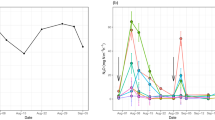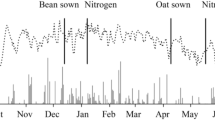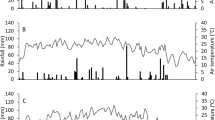Abstract
Enhanced efficiency nitrogen fertilisers (EENFs) attempt to improve nitrogen use efficiency (NUE) by synchronizing nitrogen (N) supply with crop demand to improve crop productivity/profitability and minimize environmental impacts. This study evaluated the impact of ten EENFs (at 125 and 250 kg N ha−1) compared to urea-N (at 0, 62.5, 125, 175, 250 and 300 kg N ha−1) subsurface banded in a no-till maize (Zea mays L.) production system. Crop growth was examined in both the year of application and in the following year (without fertiliser N) to assess residual impacts. Nitrous oxide emissions from a subset of EENFs applied at 150 kg N ha−1 in an adjacent experiment were monitored in year 1. Grain yield increased with increasing rates of applied urea-N in year 1, with a maximum potential yield of 11.2 t ha−1 achieved at ≥ 175 kg N ha−1. However, grain and biomass yield, agronomic NUE, and N transfer efficiency did not increase with EENFs compared to urea-N, and some controlled release fertilisers (CRFs) decreased yield by 9–16%. Nitrification inhibitors decreased cumulative N2O emissions by 67%, while CRFs had no significant effect. Residual fertiliser N remaining in the soil at the end of the first season was strongly correlated with grain yield in the subsequent cropping year, but EENFs did not have a greater residual impact on crop growth than urea-N. The inability of EENFs to deliver increased crop N uptake or grain yield does not provide a clear case for their use as an alternative to conventional urea.





Similar content being viewed by others
References
Abalos D, Jeffery S, Drury CF, Wagner-Riddle C (2016) Improving fertilizer management in the U.S. and Canada for N2O mitigation: understanding potential positive and negative side-effects on corn yields. Agric Ecosyst Environ 221:214–221. https://doi.org/10.1016/j.agee.2016.01.044
Abalos D, Jeffery S, Sanz-Cobena A, Guardia G, Vallejo A (2014) Meta-analysis of the effect of urease and nitrification inhibitors on crop productivity and nitrogen use efficiency. Agric Ecosyst Environ 189:136–144
Aliyu G, Luo J, Di HJ, Liu D, Yuan J, Chen Z, He T, Ding W (2021) Yield-scaled nitrous oxide emissions from nitrogen-fertilized croplands in China: a meta-analysis of contrasting mitigation scenarios. Pedosphere 31:231–242. https://doi.org/10.1016/S1002-0160(20)60074-1
Alonso-Ayuso M, Gabriel JL, Quemada M (2016) Nitrogen use efficiency and residual effect of fertilizers with nitrification inhibitors. Eur J Agron 80:1–8
Arnall D, Mallarino A, Ruark M, Varvel G, Solie J, Stone M, Mullock J, Taylor R, Raun W (2013) Relationship between grain crop yield potential and nitrogen response. Agron J 105:1335–1344
Bell MJ, Briggs J, McKeller L, Connellan J, DiBella L, Dwyer R, Empson M, Garside AJ, Harvey T, Kraak J, Lakshmanan P, Lamb DW, Meier E, Moody P, Muster T, Palmer J, Robinson N, Robson A, Salter B, Schroeder B, Silburn M, Schmidt S, Skocaj DM, Stacey S, Stanley J, Thorburn P, Verburg K, Walker C, Wang W, Wood A (2015) A review of nitrogen use efficiency in sugarcane. Sugar Research Australia, Australia
BOM (2020) Bureau of meterology. http://www.bom.gov.au/. Accessed 03 Dec 2020
Ciampitti IA, Vyn TJ (2011) A comprehensive study of plant density consequences on nitrogen uptake dynamics of maize plants from vegetative to reproductive stages. Field Crop Res 121:2–18
Ciampitti IA, Vyn TJ (2012) Physiological perspectives of changes over time in maize yield dependency on nitrogen uptake and associated nitrogen efficiencies: a review. Field Crop Res 133:2–18
De Antoni MM, Bell M, Lester D, Rowlings DW, Scheer C, de Rosa D, Grace PR (2016) Comparison of grain yields and N2O emissions on Oxisol and Vertisol soils in response to fertiliser N applied as urea or urea coated with the nitrification inhibitor 3,4-dimethylpyrazole phosphate. Soil Res 54:552–564. https://doi.org/10.1071/SR15336
De Antoni MM, Scheer C, Grace PR, Rowlings DW, Bell M, McGree J (2014) Influence of different nitrogen rates and DMPP nitrification inhibitor on annual N2O emissions from a subtropical wheat–maize cropping system. Agric Ecosyst Environ 186:33–43. https://doi.org/10.1016/j.agee.2014.01.016
Dimkpa CO, Fugice J, Singh U, Lewis TD (2020) Development of fertilizers for enhanced nitrogen use efficiency: trends and perspectives. Sci Total Environ 731:139113
Dobermann AR (2005) Nitrogen use efficiency—state of the art. Paper presented at the IFA international workshop on enhanced-efficiency fertilizers, Frankfurt, Germany, 28–30 June, 2005
FAO (2020) Food and agriculture statistics. Accessed 10 Oct 2020
Feng J, Li F, Deng A, Feng X, Fang F, Zhang W (2016) Integrated assessment of the impact of enhanced-efficiency nitrogen fertilizer on N2O emission and crop yield. Agric Ecosyst Environ 231:218–228
Friedl J, Scheer C, Rowlings DW, Mumford MT, Grace PR (2017) The nitrification inhibitor DMPP (3,4-dimethylpyrazole phosphate) reduces N2 emissions from intensively managed pastures in subtropical Australia. Soil Biol Biochem 108:55–64. https://doi.org/10.1016/j.soilbio.2017.01.016
Grace PR, van der Weerden TJ, Rowlings DW, Scheer C, Brunk C, Kiese R, Butterbach-Bahl K, Rees RM, Robertson GP, Skiba UM (2020) Global Research Alliance N2O chamber methodology guidelines: considerations for automated flux measurement. J Environ Qual 49:1126–1140. https://doi.org/10.1002/jeq2.20124
Graham RF, Greer KD, Villamil MB, Nafziger ED, Pittelkow CM (2018) Enhanced-efficiency fertilizer impacts on yield-scaled nitrous oxide emissions in maize. Soil Sci Soc Am J 82:1469–1481. https://doi.org/10.2136/sssaj2018.05.0196
Halvorson AD, Del Grosso SJ (2012) Nitrogen source and placement effects on soil nitrous oxide emissions from no-till corn. J Environ Qual 41:1349–1360. https://doi.org/10.2134/jeq2012.0129
Halvorson AD, Del Grosso SJ (2013) Nitrogen placement and source effects on nitrous oxide emissions and yields of irrigated corn. J Environ Qual 42:312–322
Halvorson AD, Snyder CS, Blaylock AD, Del Grosso SJ (2014) Enhanced-efficiency nitrogen fertilizers: potential role in nitrous oxide emission mitigation. Agron J 106:715–722. https://doi.org/10.2134/agronj2013.0081
Isbell R (2016) The Australian soil classification. CSIRO Publishing, Melbourne
IUSS (2014) IUSS Working Group - World Reference Base for Soil Resources 2014. International soil classification system for naming soils and creating legends for soil maps. FAO, Rome
Janke CK, Moody P, Bell MJ (2020) Three-dimensional dynamics of nitrogen from banded enhanced efficiency fertilizers. Nutr Cycl Agroecosyst 118:227–247
Kelly JR (2008) Nitrogen effects on coastal marine ecosystems. In: Nitrogen in the environment. pp 271–332. doi:https://doi.org/10.1016/B978-0-12-374347-3.00010-X
Ladha JK, Pathak H, Krupnik TJ, Six J, van Kessel C (2005) Efficiency of fertilizer nitrogen in cereal production: retrospects and prospects vol 87. doi:https://doi.org/10.1016/S0065-2113(05)87003-8
Lester DW, Bell MJ, Bell KL, De Antoni MM, Scheer C, Rowlings D, Grace PR (2016) Agronomic responses of grain sorghum to DMPP-treated urea on contrasting soil types in north-eastern Australia. Soil Research 54:565–571
Linquist BA, Liu L, van Kessel C, van Groenigen KJ (2013) Enhanced efficiency nitrogen fertilizers for rice systems: meta-analysis of yield and nitrogen uptake. Field Crop Res 154:246–254
Liu S, Wang X, Yin X, Savoy HJ, McClure A, Essington ME (2019) Ammonia volatilization loss and corn nitrogen nutrition and productivity with efficiency enhanced UAN and Urea under No-tillage. Scic Rep 9:6610. doi:https://doi.org/10.1038/s41598-019-42912-5
Lourenço KS, Cantarella H, Soares JR, Gonzaga LC, Menegale PLDC (2021) DMPP mitigates N2O emissions from nitrogen fertilizer applied with concentrated and standard vinasse. Geoderma. https://doi.org/10.1016/j.geoderma.2021.115258
Martins MR, Sant’Anna SAC, Zaman M, Santos RC, Monteiro RC, Alves BJR, Jantalia CP, Boddey RM, Urquiaga S (2017) Strategies for the use of urease and nitrification inhibitors with urea: Impact on N2O and NH3 emissions, fertilizer-15N recovery and maize yield in a tropical soil. Agric Ecosyst Environ 247:54-62. doi: https://doi.org/10.1016/j.agee.2017.06.021
Naz MY, Sulaiman SA (2016) Slow release coating remedy for nitrogen loss from conventional urea: a review. J Control Release 225:109–120
Omonode RA, Halvorson AD, Gagnon B, Vyn TJ (2017) Achieving lower nitrogen balance and higher nitrogen recovery efficiency reduces nitrous oxide emissions in North America’s maize cropping systems. Front Plant Sci. https://doi.org/10.3389/fpls.2017.01080
Omonode RA, Vyn TJ (2019) Tillage and nitrogen source impacts on relationships between nitrous oxide emission and nitrogen recovery efficiency in corn. J Environ Qual 48:421–429. https://doi.org/10.2134/jeq2018.05.0188
Quemada M, Alonso-Ayuso M, Castellano-Hinojosa A, Bedmar EJ, Gabriel JL, García González I, Valentín F, Calvo M (2019) Residual effect of synthetic nitrogen fertilizers and impact on Soil Nitrifiers. Eur J Agron. https://doi.org/10.1016/j.eja.2019.125917
Quemada M, Baranski M, Nobel-de Lange MNJ, Vallejo A, Cooper JM (2013) Meta-analysis of strategies to control nitrate leaching in irrigated agricultural systems and their effects on crop yield. Agric Ecosyst Environ 174:1–10. https://doi.org/10.1016/j.agee.2013.04.018
Rayment GE, Lyons DJ (2010) Soil chemical methods—Australasia. doi:https://doi.org/10.1071/9780643101364
Rowlings DW, Scheer C, Liu S, Grace PR (2016) Annual nitrogen dynamics and urea fertilizer recoveries from a dairy pasture using 15N; effect of nitrification inhibitor DMPP and reduced application rates. Agric Ecosyst Environ 216:216–225. https://doi.org/10.1016/j.agee.2015.09.025
Scheer C, Rowlings DW, De Antoni MM, Lester DW, Bell MJ, Grace PR (2016) Effect of enhanced efficiency fertilisers on nitrous oxide emissions in a sub-tropical cereal cropping system. Soil Res 54:544–551
Schwenke GD, Haigh BM (2019) Urea-induced nitrous oxide emissions under sub-tropical rain-fed sorghum and sunflower were nullified by DMPP, partially mitigated by polymer-coated urea, or enhanced by a blend of urea and polymer-coated urea. Soil Res 57:342–356. https://doi.org/10.1071/SR18285
Souza EFC, Rosen CJ, Venterea RT (2021) Co-application of DMPSA and NBPT with urea mitigates both nitrous oxide emissions and nitrate leaching during irrigated potato production. Environ Pollut 284:117124. https://doi.org/10.1016/j.envpol.2021.117124
Steusloff TW, Nelson KA, Motavalli PP, Singh G (2019) Fertilizer placement affects corn and nitrogen use efficiency in a claypan soil. Agron J 111:2512–2522. https://doi.org/10.2134/agronj2019.02.0108
Thapa R, Chatterjee A, Awale R, McGranahan DA, Daigh A (2016) Effect of enhanced efficiency fertilizers on nitrous oxide emissions and crop yields: a meta-analysis. Soil Sci Soc Am J 80:1121–1134. https://doi.org/10.2136/sssaj2016.06.0179
Timilsena YP, Adhikari R, Casey P, Muster T, Gill H, Adhikari B (2015) Enhanced efficiency fertilisers: a review of formulation and nutrient release patterns. J Sci Food Agric 95:1131–1142
Trenkel ME (2010) Slow- and controlled-release and stabilized fertilizers: An option for enhancing nutrient use efficiency in agriculture. International Fertilizer Industry Association, Paris, France
Venterea RT, Halvorson AD, Kitchen N, Liebig MA, Cavigelli MA, Del Grosso SJ, Motavalli PP, Nelson KA, Spokas KA, Singh BP, Stewart CE, Ranaivoson A, Strock J, Collins H (2012) Challenges and opportunities for mitigating nitrous oxide emissions from fertilized cropping systems. Front Ecol Environ 10:562–570. https://doi.org/10.1890/120062
Wang WJ, Reeves SH, Salter B, Moody PW, Dalal RC (2016) Effects of urea formulations, application rates and crop residue retention on N2O emissions from sugarcane fields in Australia. Agric Ecosyst Environ 216:137–146. https://doi.org/10.1016/j.agee.2015.09.035
Woodley AL, Drury CF, Yang XY, Phillips LA, Reynolds DW, Calder W, Oloya TO (2020) Ammonia volatilization, nitrous oxide emissions, and corn yields as influenced by nitrogen placement and enhanced efficiency fertilizers. Soil Sci Soc Am J 84:1327–1341. https://doi.org/10.1002/saj2.20079
Zaman M, Zaman S, Nguyen ML, Smith TJ, Nawaz S (2013) The effect of urease and nitrification inhibitors on ammonia and nitrous oxide emissions from simulated urine patches in pastoral system: a two-year study. Sci Total Environ 465:97–106
Zhang W, Liang Z, He X, Wang X, Shi X, Zou C, Chen X (2019) The effects of controlled release urea on maize productivity and reactive nitrogen losses: a meta-analysis. Environ Pollut 246:559–565. https://doi.org/10.1016/j.envpol.2018.12.059
Zhang X, Davidson EA, Mauzerall DL, Searchinger TD, Dumas P, Shen Y (2015) Managing nitrogen for sustainable development. Nature 528:51–59
Acknowledgements
The authors would like to thank Max De Antoni Migliorati, Julie Renwick, Kurt Deifel and Rowan Mason for their excellent support during field data collection.
Funding
This research was supported by the National Environmental Sciences Program (Tropical Water Quality Hub) project 2.1.8 ‘Improved Water Quality Outcomes from On-Farm Nitrogen Management’ and the University of Queensland Science with Impact Fund (SWIF).
Author information
Authors and Affiliations
Corresponding author
Ethics declarations
Conflict of interest
The authors declare no conflict of interest.
Additional information
Publisher's Note
Springer Nature remains neutral with regard to jurisdictional claims in published maps and institutional affiliations.
Supplementary Information
Below is the link to the electronic supplementary material.
Rights and permissions
About this article
Cite this article
Dang, Y.P., Martinez, C., Smith, D. et al. Maize production and nitrous oxide emissions from enhanced efficiency nitrogen fertilizers. Nutr Cycl Agroecosyst 121, 191–208 (2021). https://doi.org/10.1007/s10705-021-10171-4
Received:
Accepted:
Published:
Issue Date:
DOI: https://doi.org/10.1007/s10705-021-10171-4




